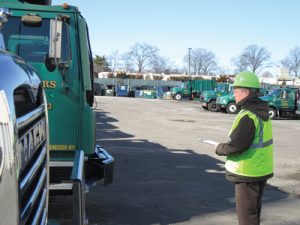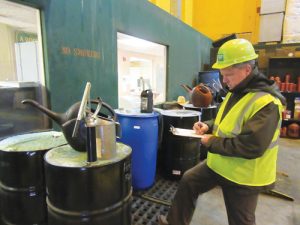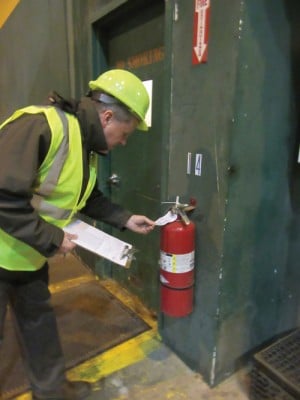Conducting regular internal reviews of transfer stations, recycling centers, landfills, maintenance shops and other solid waste and recycling facilities will help identify potential worker safety hazards before anyone gets hurt.
By Will Flower



Monthly or quarterly inspections of facilities can help to ensure facilities and operations are in compliance with federal, state and local environmental laws, rules and regulations. A properly trained facility manager, safety manger, supervisor or team of qualified individuals should conduct inspections. It can also be advantageous to hire a third-party safety expert to review and evaluate a facility with a “fresh set of eyes.”
What to Look For
Facility inspections can focus on environmental regulations, safety rules, transportation laws or any combination of compliance and safety issues. Many waste and recycling companies use checklists to aid the inspection process and ensure that important items are not overlooked.
Some of the items that can be included on a facility inspection checklist include:
- Historic Issues—All prior compliance issues and violations should be reviewed to make certain that you don’t have repeat violations.
- Building and Grounds—Take a look at everything from the fence surrounding the facility, condition of paving around the facility, storm water drainage and site security. Inside the building review the condition of building including floors, stairs, walkways and lighting.
- Fire Safety—Check on fire extinguishers to make sure an adequate number are available and properly charged and labeled. Ensure that the proper type of extinguishes (water, dry chemical, etc.) are available to battle a potential fire. Review the access to firefighting equipment to make sure there are no obstructions. Evaluate fire alarms, sprinklers, smoke detectors to ensure they are functioning. Review escape routes and exits to guarantee they are clear and unobstructed.
- Permit Conditions—Every permit will have specific permit conditions that need to be reviewed to make certain that the facility is in full compliance. Inspectors must be knowledgeable about a facility’s permits in order to conduct a thorough review. And importantly, many permits have reporting requirements with deadlines that need to be met to stay in compliance.
- Unloading Areas—The tip floor and the active face of a landfill are potentially dangerous areas because people and moving equipment meet. Inspectors should pay particular attention to traffic flow, material flow and general operations to identify conflicts. Inspectors should carefully observe unloading areas over a period of time to determine if safety rules and best practices are being followed to ensure the safety of all workers.
- General Housekeeping—Are things generally neat and orderly?
- Liquid and Chemical Storage—Liquid and chemical storage may have special storage requirements. Storage areas should be checked to make sure they are clean, properly labeled and have adequate containment in the event of a spill. Review hazard communication requirements such as MSDS and postings.
- Spills—Spills should be immediately addressed and not left on the ground to cause a potential slip and fall hazard, fire hazard or environmental threat.
- Proper signage—Everything from evacuation routes to fire extinguisher locations to emergency telephone numbers should be clearly posted for use in an emergency.
- Lighting—Are lights working and are there enough lights for employees to clearly see and perform their jobs?
- Electricity—Wiring, switches, circuit breakers, junction boxes, cords and motors should be reviewed to make sure that workers are protected from electrical shock.
- Ladders—Are ladders properly stored and regularly inspected? Are people using the ladders properly trained in ladder care and use?
- Recycling Equipment—Make sure pulleys, sprockets, belts chains and conveyors are properly guarded. Make sure that e-stops or emergency shut off switches are easily accessible and operational.
- Lock Out, Tag Out—Lockout/tagout procedures will save lives. Make sure that the proper lockout/tagout tools such as padlocks are readily available. Also make sure employees are properly trained in lockout/tagout procedures.
- Personal Protective Equipment—Employees must have proper personal protective equipment or PPE for their job. Identify what is required such as eye protection, hearing protection, face shields, hard hats and high visibility vests.
The checklist items above are just a few of the potential items that be reviewed at a facility. A very thorough list of checklist items for self-inspection can be found in the OSHA Small Business Handbook available on OSHA’s Web site.
Stick to a Regular Inspection Schedule
The use of a checklist will help you effectively move through the inspection in a systematic and timely fashion. However, trained inspectors will look beyond the checklist and have the ability to identify concerns that are not on the checklist. Bottom line is that anything that does not look safe should be identified in the inspection report.
Once the inspection is complete, the results should be reviewed at staff meetings to ensure that issues are addressed and corrected in a timely manner. People must be given assignments to correct deficiencies and report back when corrections are made. Common or repeat issues can help the safety manager and site manager determine areas where additional training is needed.
Over time, facility inspections should become easier as employees become better trained and as the number of potential hazards decrease. Our goal is to have a robust inspection program that is not able to identify any concerns because compliance and safety issues are immediately corrected on the spot by the first employee aware of the problem. Until that time, stick to a regular schedule for inspections.
Next month’s safety tip will discuss how to talk with employees about safety—from one-on-one coaching sessions to large group safety meetings. | WA
Will Flower is the Vice President of Corporate and Public Affairs at Winters Bros. Waste Systems. Will has 32 years of experience in the area of solid waste management and environmental protection. He has held operational and executive leadership positions at the Director’s Office of the Illinois Environmental Protection Agency, Waste Management, Inc., Republic Services. Inc. and Green Stream Recycling.
Share your safety tip. Submit your suggestions to Will Flower at [email protected].
